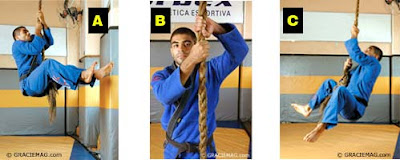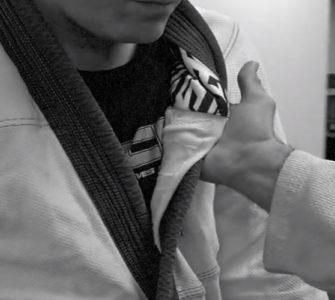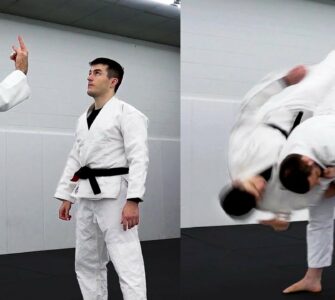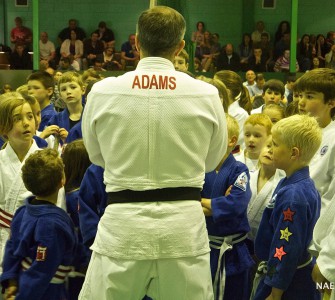Establishing good grips in BJJ and Judo is so important as very often when you dominate the grip battle and establish your dominant grips you can control and dominate your opponent. I personally work my grips by climbing rope and doing pull ups with my gi. I also rock climb whenever I have the time (Check out our article benefits of rock climbing for BJJ) Many top BJJ players use rope climbing as a staple of their daily training. Fernando Margarida was said to have spent at least an hour per day on his rope training.
Rope climbing is fun and you can really feel yourself get better every time.
 |
| Gi pull ups |
The legendary Vitor Shaolin Ribeiro explains here how to work diffrent chokes and your abs:
“There are three ways of climbing, each of which improves a specific group of moves. In the first exercise (picture A), we use short grips to get to the top, which helps in the chokes executed with the hands near and the arms bent. As he shows, the climb can be made with the hand reversed (picture B). In the following task (picture C) he goes upwards with wider grips, ideal to strengthen a pull from the ground with a hip escape (bottom picture) or any position that demands a strong grip with the arms stretched. The detail is to keep the legs always elevated, which toughens the abs. “You go up, stop for a few seconds with the legs stretched, and then descend in the same fashion,” explains the Nova Uniao professor. “The wider grip is the hardest, so I do it only once a day, five times a week. The other one, easier, I repeat ten times a week, twice on one day, thrice on the next, then twice… Always after training, when the arms are more tired.”
Here is a nice little video of rope climbing after BJJ practice, notice how his legs are elevated in a close guard to work the legs and abs as well:
Sally Arsenault wrote a great article on the subject of grip training for BJJ in http://breakingmuscle.com/ here are the best parts:
“I’ve rolled with people who had such good grips they rag-dolled me from their guard before pulling me into a sweep or submission and there was nothing I could do about it. To combat this I’ve been doing research on grip training and talking to veteran grapplers about how to strengthen it.
First let’s understand the common grips in BJJ:
Hook grip – grip the cuff of your partner’s gi sleeve from the outside by grabbing excess material and tucking it into the cuff with four fingers
Pistol grip – grip the excess fabric of the sleeve or pant leg similar to the way you would grasp the handle bar of a bicycle. Either place your hand on the outside of the sleeve or use a cross grip.
Two-on-one – a cuff grip with an additional grip of the excess material at the elbow on your opponent’s arm.
Lapel and sleeve – One hand grips the lapel while the other hand grips the sleeve.When getting grips, remember to ensure the thumb is not in a position to get caught in the gi during a scramble. Also note it is illegal in tournament, as well as dangerous, to grip inside the sleeve or pants cuff.
In the video below, my teammates at Titans MMA demonstrate common grips and their uses, particularly in relation to spider guard:
How to Train Grip Strength
Supplemental strength and conditioning training for BJJ and MMA sometimes overlooks grip strength specific training. During my training, I’ve missed reps in deadlifts and pull ups because of my weak grip. A machine is only as strong as its weakest part and for me the weakest link was my hands. Serious powerlifters often use hooks or straps to help them lift heavy in the deadlift but in BJJ, our hands are our only option.
There are several different ways to train grip strength:
Climbing
Hanging
Holding
Pulling
Technical drillsClimbing
Rope climbing, using progressive difficulty as well as timed holds, is great for gi and no-gi grip strength due to the girth of the rope. Another great way to improve grip is rock climbing. Not all of the grips used in rock climbing are similar to those used in BJJ, but they do help to increase hand and forearm strength.
Hanging
Convict Conditioning 2 by Paul “Coach” Wade suggests the following progression after adequate warm up (Note: I would do grip work at the end of my strength workout in order to have a fresh grip for training and a nice warm up for grip work):
Using a vertical bar, hang from two hands. Once you can do that for 60 seconds, switch to hanging from one hand until you can hold it for 60 seconds each, from there, switch to a towel or a gi with both hands, then one hand. Fold the gi or towel over for a thicker grip and repeat the same sequence until you can hang from a thickly folded gi with one hand for 60 seconds. At that point, you will have the grip of a superhero.Holding
Hold weight for 60 seconds with a dumbbell in each hand, increasing the weight as your strength builds.
Pulling
Pulling is a great way to increase grip strength, but usually the focus of pulling exercises is on other body parts, with the grip being secondary. Pulling exercises include deadlifts and rows. The other types of grip work will greatly benefit these lifts.
After a recent injury, I had to do deadlifts wearing a thick cast, which immobilized my thumb. It made me realize how much support the thumb provides. For days afterwards my forearm was sore from using the hook grip. The two most frequently used grips in BJJ are the hook grip without the thumb and the typical grip with thumb support. When training grips, you can alternate weekly.Technical Drills
A good drill for grips is to grip your partner’s gi in various places like the sleeve or the lapel and have him or her strip your grip. Switch from offense to defense.
Grip strength can take a long time to build and it can be frustrating when rolling with stronger, or more skilled, opponents. It will come in time – you just have to hold on.”
















